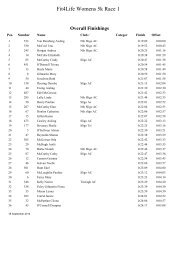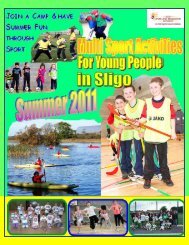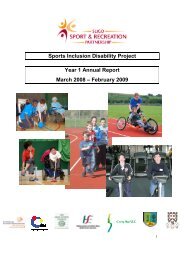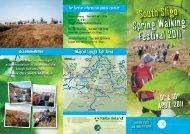Girls Active Programme - Sligo Sport and Recreation Partnership
Girls Active Programme - Sligo Sport and Recreation Partnership
Girls Active Programme - Sligo Sport and Recreation Partnership
You also want an ePaper? Increase the reach of your titles
YUMPU automatically turns print PDFs into web optimized ePapers that Google loves.
Findings<br />
mentioned that the school organises a healthy<br />
eating programme <strong>and</strong> in his observations linked<br />
this with the school’s commitment to <strong>Girls</strong> <strong>Active</strong>.<br />
Support from the steering group. Both the principal<br />
<strong>and</strong> co-ordinator were appreciative of the support<br />
from the steering group. The principal stated that<br />
this support was vital for both the school <strong>and</strong> the coordinator,<br />
<strong>and</strong> the latter mentioned the training day<br />
<strong>and</strong> the constant contact with support personnel in<br />
a positive light:<br />
“I feel they’re there when you need them, <strong>and</strong> they<br />
don’t interfere at the same time”<br />
The future. To improve the programme <strong>and</strong> attract<br />
more participants the girls suggested that an<br />
expansion of the initiative to bring in more class<br />
groups <strong>and</strong> greater choices regarding the variety<br />
of activities <strong>and</strong> whether or not to participate would<br />
be appropriate. Some also expressed a wish for the<br />
programme to be broadened to include interested<br />
boys <strong>and</strong> ‘sporty’ girls.<br />
“I’m not bothered if boys are allowed to do it. We<br />
could share the fun with the class <strong>and</strong> talk about it<br />
afterwards” (Girl)<br />
Both staff members also referred to the possibility of<br />
broadening out the programme to include a “Boys<br />
<strong>Active</strong>”, although the principal acknowledged that<br />
this would require funding that is not presently<br />
available. However, both were quite determined<br />
that the <strong>Girls</strong> <strong>Active</strong> programme will continue at<br />
the school with or without ongoing support from<br />
outside. The principal is committed to providing<br />
discretionary funding for this if that becomes<br />
necessary. The co-ordinator reinforced this<br />
assertion with her comments:<br />
“It’s [<strong>Girls</strong> <strong>Active</strong>] here to stay. The principal is 100%<br />
behind this – we’ll find the money”<br />
4.2.2 School B<br />
Background. School B first participated in <strong>Girls</strong><br />
<strong>Active</strong> in 2004/5 (Phase Two) <strong>and</strong> continued to<br />
take part in Phase Three (2005/6). The school had<br />
developed links with the Health Service Executive<br />
(HSE) through its Healthy Schools <strong>Programme</strong><br />
<strong>and</strong> considered that <strong>Girls</strong> <strong>Active</strong> would work well<br />
with it. The school has a sporting tradition where<br />
games are organised for lunchtime. The principal<br />
observed that girls did not have the same interest<br />
as boys <strong>and</strong> that “for those who don’t like football<br />
there was nothing else apart from PE”. In view of<br />
this, she felt that <strong>Girls</strong> <strong>Active</strong> might encourage<br />
more girls to take up physical activity, especially<br />
senior girls:<br />
“The juniors are very into sport anyway ... girls drop<br />
off games after junior cert, <strong>Girls</strong> <strong>Active</strong> is a good way<br />
of hooking them in again”<br />
The appointed co-ordinator had trained some girls<br />
in basketball but had more of an interest in nonsport<br />
physical activity (she was not the PE teacher<br />
in the school). She described the principal as being<br />
very supportive of the programme.<br />
Any fifth year student (15-17yr old) who was not<br />
involved in sport outside of school <strong>and</strong> who wished<br />
to do so was permitted to participate. Fifth year was<br />
selected partly because it had high numbers <strong>and</strong><br />
the co-ordinator could be confident of recruiting 20<br />
girls from it <strong>and</strong> partly because of an awareness<br />
that senior girls tend to drop out of games after<br />
Junior Cert. In the event, 20 girls took part in the<br />
first two activities (aerobics <strong>and</strong> modern dance)<br />
<strong>and</strong> 15 in the third (gym & swim).<br />
“We didn’t need encouragement to get involved, we<br />
volunteered because it sounded good ... we choose<br />
the activities” (Girl)<br />
The local leisure centre assisted the co-ordinator<br />
in locating instructors for the first two activities<br />
<strong>and</strong> she consequently decided to utilise the centre<br />
itself for the third activity. One instructor came at<br />
lunchtime but neither of the other two was available<br />
at that time <strong>and</strong> so these activities had to take place<br />
after school. The girls were asked to contribute<br />
one euro per week to supplement the fees of the<br />
instructors.<br />
18<br />
Evaluation of the <strong>Girls</strong> <strong>Active</strong> <strong>Programme</strong> - 2003 – 2005 Report











